This salmon almondine is made with pan-seared salmon topped with buttery, golden almond slices for a delicious seafood dinner.

Who else is on a constant search for your next favorite salmon dinner?
Here at Champagne Tastes, we love salmon. We love it a lot.
We pan-sear salmon, broil salmon, and cook it as often (and as many ways) as possible!
We've been enjoying sweet chili salmon, teriyaki salmon, salmon Wellington, salmon Caesar salad, pesto salmon, air-fryer salmon... all the salmon!
If you follow along with our Instagram stories, you'll probably see lots of salmon!
Recently, though, as I was preparing a side of green bean almondine, I started thinking about salmon. As much as I love nut-crusted fish (like this pecan-crusted bourbon salmon), the topping can (sometimes) be a little finicky.
I found myself wishing that salmon with a nut topping was as simple to prepare as the almond topping I serve with my green beans. Then I realized, it can be.
This salmon almondine is made with pan-seared salmon topped with a buttery, toasted almond topping.
Want even more salmon ideas? We also love these slow-roasted salmon sandwiches, salmon sandwiches with Dijon sauce, salmon quiche, seared salmon with grapes, baked mustard salmon and grilled salmon with pineapple.
What Kind of Salmon Should I Use?
I love to make this with light, leaner types of salmon.
Salmon almondine is delicious with pink salmon, coho salmon (pictured), and keta or chum) salmon. While I wouldn't call sockeye salmon lean, the wild sockeye flavor contrasts really well with the buttery almonds.
You could make this with rich, fatty salmon (like King salmon), but keep in mind that the topping is also very rich. King salmon isn't my preference with this recipe.
I prefer to use King salmon with lighter or acidic flavors, like this seared salmon with cherries, grilled salmon with plum sauce, or poached salmon with blueberries.
Love Atlantic salmon? You can use that too, but look for Best Aquaculture Practices (BAP) certification.
All commercially sold Atlantic salmon is farmed. Read more about the difference between farmed and wild salmon.
You can also make a similar dish with halibut or lingcod! Check out our white fish variation, fish almondine, or this trout almondine.
What Kind of Almonds Should I Use for Salmon Almondine?
If possible, use raw almonds, not pre-toasted almonds. You'll be toasting the almonds yourself.
I bought raw sliced almonds (because pre-sliced are easier and faster), but it's fine if you want to slice the almonds yourself.
How to Make the Salmon Almondine Topping
Start by melting butter in a large, shallow pan. I use this Lodge 12" carbon steel skillet.
Add the almonds to the butter, and cook until they're golden (about two minutes).
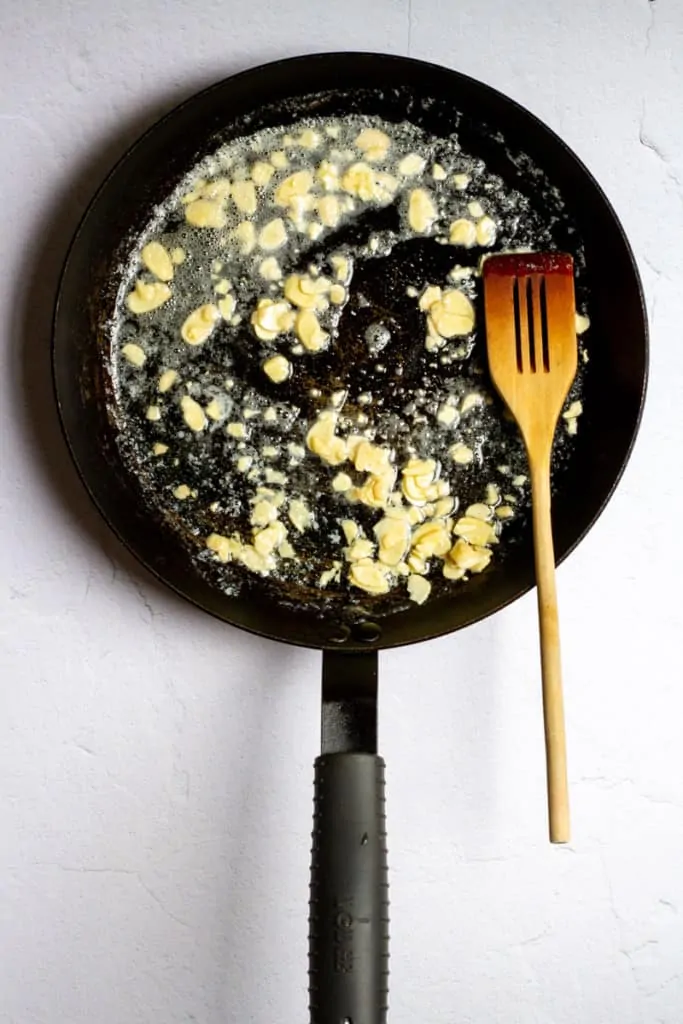
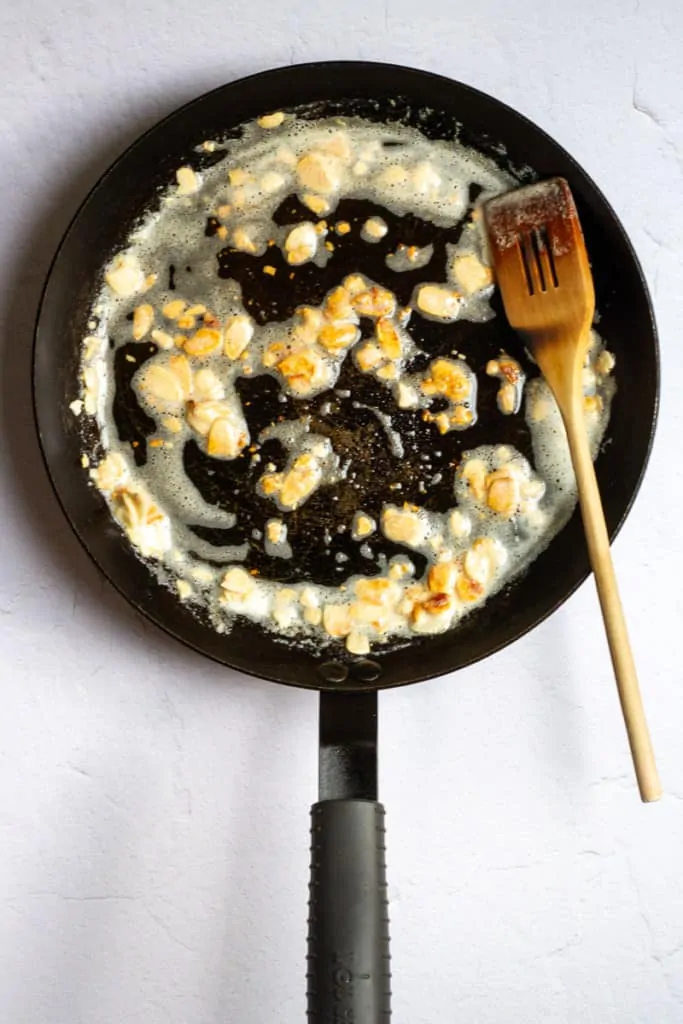
Scoop the almonds out of the pan and set aside, leaving as much butter behind as possible.
Pan-Sear the Salmon
Next, add a little oil in to the pan with the butter and increase the heat to medium. Place the salmon skin-side down in the pan and then do not touch it.

As the salmon cooks, it will become opaque from the bottom up.
When it's about halfway cooked-through, slide a thin metal spatula under the fish.
I use a Wusthof fish spatula, but have also heard great things about this OXO fish spatula.
If the fish sticks to the pan, leave it for a few more seconds, and then try again.
Flip the fish, and cook until it's opaque and tender.

Take the salmon out of the pan, then and add lemon juice and fresh herbs to the hot butter.
Cook the juice for a moment or two, scraping up any bits of salmon that stuck to the pan. Turn off the heat.
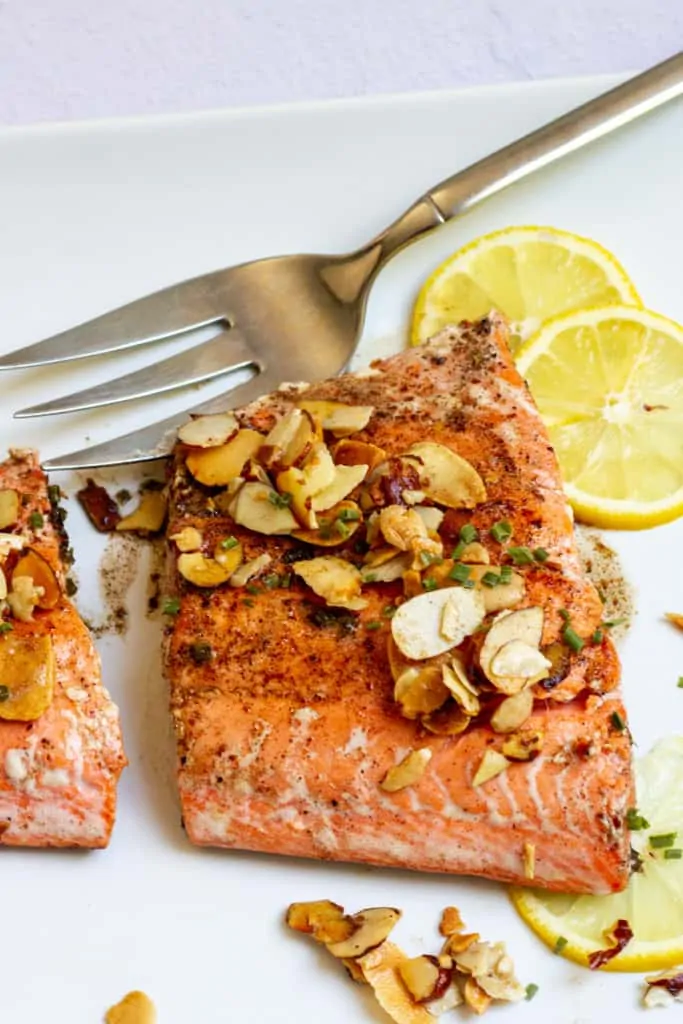
Serve the salmon along with the lemon pan-sauce, the toasted almonds, and more fresh herbs.
I recommend serving this salmon almondine along with French mashed potatoes, a kale apple salad, and a glass of your favorite dry white or red wine.

Salmon Almondine
Ingredients
- 8 ounces salmon (2 fillets)
- pinch salt, pepper
- 2 tablespoons butter, divided
- ¼ cup almond slices
- 1 tablespoon olive oil
- 1 lemon, juiced
- Handful fresh herbs (parsley, chives, basil, cilantro etc)
Instructions
- Pat salmon dry. Sprinkle fillets on both sides with salt and pepper.

- In a large shallow pan, melt half the butter (1 tablespoon) over medium-low heat.When the butter is melted (but not browned) add the almonds and cook until the nuts are golden (2-3 minutes). Scoop the almonds out of the butter and set aside.Tip: The butter will foam as you cook, which could make it harder to see the almonds. Keep a close eye on the almonds as you cook to ensure that they don't burn.
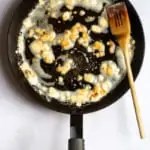
- Increase heat to medium. Add remaining 1 tablespoon butter and the olive oil to the pan. (If using a very fatty type of salmon, such as King salmon, skip the olive oil).Place the fillets in the pan and cook 2-4 minutes, depending on the thickness of the fillets.As the fish cooks, the flesh will begin to turn opaque from the bottom up. When the fish has cooked halfway through, it's ready to flip.Avoid touching the fish until the fish is ready to flip.
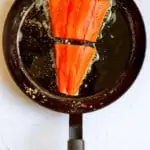
- Use a thin metal spatula to test the fish. If you can slide the spatula under the fish without the fish sticking to the pan, it's ready to flip. If the fillets won't release- give them another 30 seconds. They'll release when they've finished cooking.Cook fish another 2-4 minutes until done. Timing will depend on the thickness of the fillet. (Watch the sides of the fillets to see when the fish is done cooking. It's finished as soon as there are no more translucent patches and it's fully opaque.)

- Transfer the fish to plates, leaving the excess butter in the pan. Cover fish to keep warm, or set fish in a 200ºF oven.Reduce heat to medium-low. Add the lemon juice to the pan, stir with a wooden spoon, and allow the juice to reduce for about a minute. Add half the herbs and turn off the heat. Serve fish hot with pan sauce, remaining herbs, and the toasted almonds.








Leave a Comment: